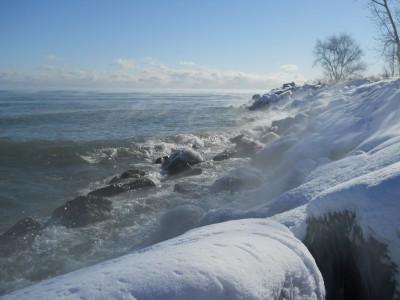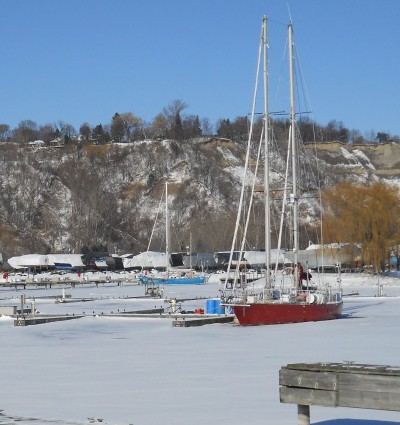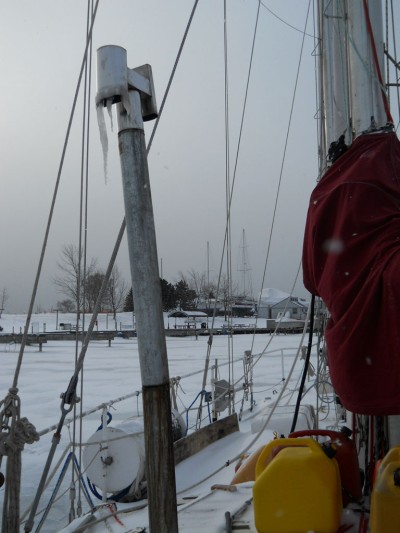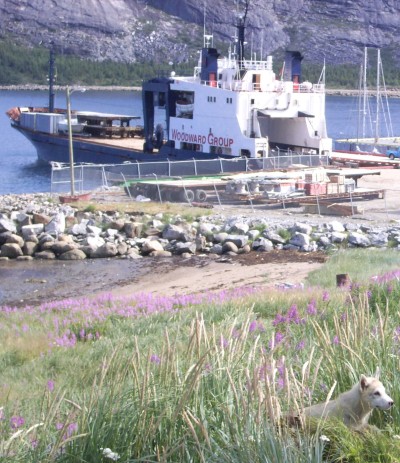Toronto, Canada
 Outside the harbor yesterday, when it was cold (-19C/-4F). The misty areas of the picture are steam coming off the water and steam from the spray when the water hits the ice-covered rocks. Today it warmed up enough to snow (for those not used to cold climates, snow requires clouds and clouds reflect heat back to the surface, so the coldest temperatures happen when there are no clouds–ie when it is not snowing).
Outside the harbor yesterday, when it was cold (-19C/-4F). The misty areas of the picture are steam coming off the water and steam from the spray when the water hits the ice-covered rocks. Today it warmed up enough to snow (for those not used to cold climates, snow requires clouds and clouds reflect heat back to the surface, so the coldest temperatures happen when there are no clouds–ie when it is not snowing).
Monthly Archives: January 2011
Contrast
Toronto, Canada
 In contrast to the previous picture of sailing on a beautiful summer day in Labrador, here is where Issuma is today, locked in the ice, which is now covered with snow. Being covered with snow means the ice wont get thicker as quickly (because snow is a good insulator), which is good, as the thicker the ice is, the longer Issuma will be stuck in the ice.
In contrast to the previous picture of sailing on a beautiful summer day in Labrador, here is where Issuma is today, locked in the ice, which is now covered with snow. Being covered with snow means the ice wont get thicker as quickly (because snow is a good insulator), which is good, as the thicker the ice is, the longer Issuma will be stuck in the ice.
Becalmed
 As Issuma is still frozen into the ice, I can only dream about sailing :), so here is a picture of Issuma this summer in Labrador.
As Issuma is still frozen into the ice, I can only dream about sailing :), so here is a picture of Issuma this summer in Labrador.
The Rope Reels
 To answer George’s comment about the reels of rope on deck. One reel stores 100m (330′) of 22mm(7/8″) polyester and 10m chain. The other reel stores 200m (660′) of 20mm (3/4″) blue polyethylene rope (underneath a cover for UV protection). These ropes are used for anchor rodes, sea anchor rodes, and as shore lines (tying the boat to shore as well as using an anchor to limit how far it will swing). We used these ropes a lot in Labrador, where we often wanted either a second anchor or a shore line. Having reels makes it quick and easy to handle long ropes. Since it is handy to have the ropes available, I leave the reels on, even when not expecting to need them for anchoring, or shore lines.The disadvantage of having these reels is that they are pretty heavy when the rope is on them, which is weight in the wrong place, and also that thay stick out, so the boat cannot go alongside a wall on the port side. Not being able to go alongside a wall on the port side is usually not a big deal, and has only occasionally been an inconvenience. The rope reels are stainless steel with plywood bolted onto the ends. There is a solid stainless steel rod going through them which they turn on. The picture was taken this summer in Hudson Strait. In the background is an ice floe with two seals on it.
To answer George’s comment about the reels of rope on deck. One reel stores 100m (330′) of 22mm(7/8″) polyester and 10m chain. The other reel stores 200m (660′) of 20mm (3/4″) blue polyethylene rope (underneath a cover for UV protection). These ropes are used for anchor rodes, sea anchor rodes, and as shore lines (tying the boat to shore as well as using an anchor to limit how far it will swing). We used these ropes a lot in Labrador, where we often wanted either a second anchor or a shore line. Having reels makes it quick and easy to handle long ropes. Since it is handy to have the ropes available, I leave the reels on, even when not expecting to need them for anchoring, or shore lines.The disadvantage of having these reels is that they are pretty heavy when the rope is on them, which is weight in the wrong place, and also that thay stick out, so the boat cannot go alongside a wall on the port side. Not being able to go alongside a wall on the port side is usually not a big deal, and has only occasionally been an inconvenience. The rope reels are stainless steel with plywood bolted onto the ends. There is a solid stainless steel rod going through them which they turn on. The picture was taken this summer in Hudson Strait. In the background is an ice floe with two seals on it.
Chilly
Toronto, Canada
 Much less appealing a picture than one of sailing in Labrador in summer, this is how Issuma looks now, frozen into the ice. Note the icicles that have formed on the chimney. Forecast is for warmer weather tomorrow, though not warm enough to melt the ice around the boat :(.
Much less appealing a picture than one of sailing in Labrador in summer, this is how Issuma looks now, frozen into the ice. Note the icicles that have formed on the chimney. Forecast is for warmer weather tomorrow, though not warm enough to melt the ice around the boat :(.
Becalmed
 This is a picture of Issuma in August, just north of Nain, Labrador, taken from the sailboat Evensong. At present, Issuma is frozen into the ice in Toronto.
This is a picture of Issuma in August, just north of Nain, Labrador, taken from the sailboat Evensong. At present, Issuma is frozen into the ice in Toronto.
Nain Harbor
 This is a view of the harbor in Nain, Labrador last August. The masts of Issuma are visible to the right of the ship. Brian, in his comment to the previous post, points out that there is still no ice in Nain, which is incredible for January.
This is a view of the harbor in Nain, Labrador last August. The masts of Issuma are visible to the right of the ship. Brian, in his comment to the previous post, points out that there is still no ice in Nain, which is incredible for January.
Thicker Ice
Toronto, Canada
 We tried to leave the harbor today for a short sail but, after an hour of breaking ice, decided to wait for a warmer day when the ice is easier to break. We could have broken our way out the rest of the channel, but I don’t really know how much ice this hull is designed for, so thought it better to wait for a warm spell before going sailing next. The temperature has been between -5C and -10C for the last few days and the ice quickly closed in and got thick. The ice we were breaking was about 13cm/5″ thick, composed of a clear, hard layer of ice and a softer, white layer of snow that became ice. In the picture, Don is pushing one of the chunks of ice down with a pole so the thickness and layers can be seen.
We tried to leave the harbor today for a short sail but, after an hour of breaking ice, decided to wait for a warmer day when the ice is easier to break. We could have broken our way out the rest of the channel, but I don’t really know how much ice this hull is designed for, so thought it better to wait for a warm spell before going sailing next. The temperature has been between -5C and -10C for the last few days and the ice quickly closed in and got thick. The ice we were breaking was about 13cm/5″ thick, composed of a clear, hard layer of ice and a softer, white layer of snow that became ice. In the picture, Don is pushing one of the chunks of ice down with a pole so the thickness and layers can be seen.